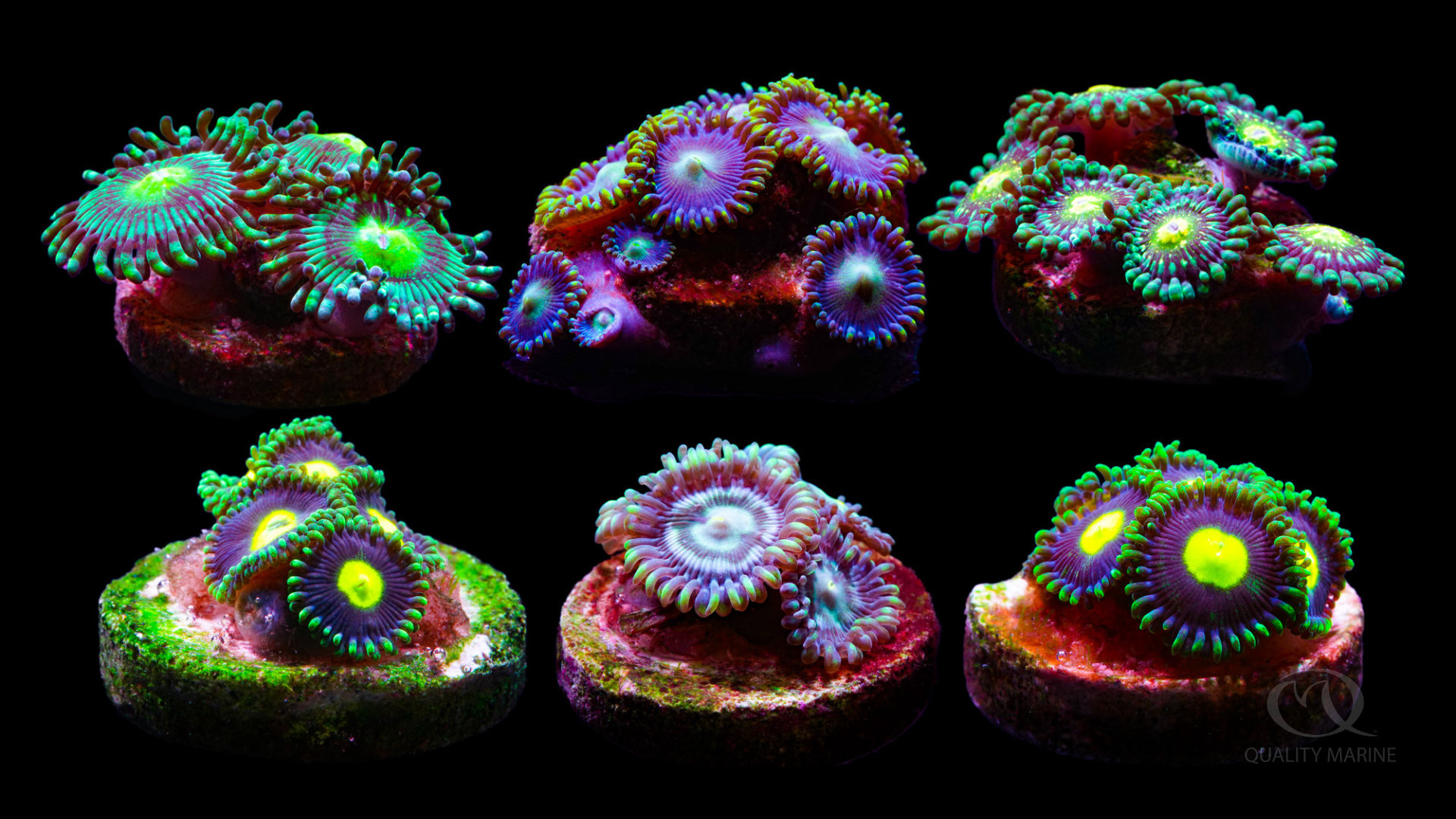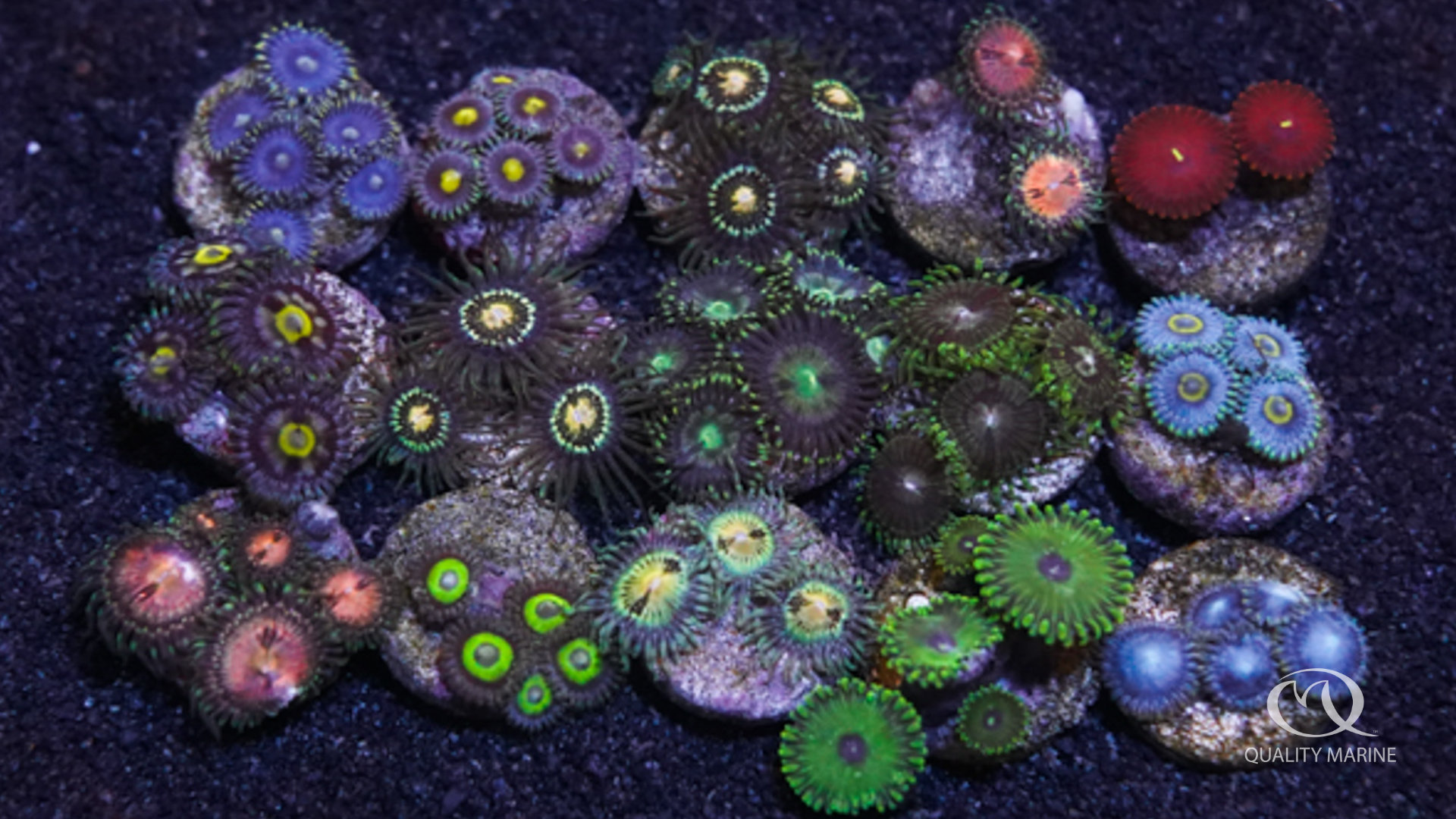Ultimate Ultra Zoanthids!

Zoanthids are the first “coral” for many marine aquarium keepers and its easy to see why. They come in a wild myriad of colors, most of them are quite hardy and grow quickly under good conditions. Among our staff favorites here are our Caribbean Ultra Zoanthids. You don't recognize the name because it isn't a brand, but there is no doubt that they are among our most beautiful polyps.
What is a Zoanthid? Simply put, it is a colonial polyp. They have daisy-like faces that come in a wild variety of colors and patterns, with a fringe surround this face like the petals of said daisy. They reproduce by budding and (creating new little buddies) ;) to attach to the rocks around them. In this way they will grow over any rocks (and other hard surfaces). They can start from a single polyp, but you'll find much faster growth starting with as many as possible. Imagine it like this: if you have one polyp and it divides once, you have two, then those two need to undergo the process again. In this way, two become four and four become eight. But if you start with 20, those twenty can become 40 if they have space. The colonial polyps do not attach to sandy substrates. As such, many hobbyists will utilize open spaces of sand between different colonies of zoanthids to keep them from overgrowing their neighbors.
Zoanthids are generally photosynthetic. Like corals, they host a microorganism that can carry out photosynthesis and this shares the sugars it creates with the polyp. The vast majority of the polyps collected are from moderate to shallow depths and will need moderate to bright lighting. They should be acclimated to this slowly. Start with them in a corner or near the bottom and over the course of days, move them into brighter and brighter locations until you find the spot you want them to take anchor and spread. Some Zoas aren't going to like super bright lighting no matter how slowly you move them and putting them into these super bright locations will cause them to change colors, sometimes with amazing results, but often times turning them brown or green. If you notice your Zoanthids stretching for the light, they likely need more of it; happy Zoas grow low and tight.

When this is the case, the Zoas likely came from very deep water where the light supply is limited, and as a result, these polyps are almost entirely dependent on feeding. Even the Zoanthids collected from shallow water will do better with supplemental foods; they do not need much food, and this food should be very small. Many coral foods like V20's Coral Mix are perfect for this. The solution we use in house is a blend of live algae products from Nutramar, which are a natural food source, and we've found excellent growth rates and the appearance of enhanced coloration in using it. Any type of food you choose can be directly fed with a baster with your flow turned off or at least way down.
This brings us to the next topic for successfully keeping your Zoanthids and this is flow. Like any invertebrate that is stuck in one place, zoanthids depend on flow for removing detritus and supplying their immediate living environment with fresh, oxygenated water. They are a soft bodied organism, and so the possibility of “too much of a good thing” is also relevant. We want gentle flow, that is not laminar (direct and constant in direction). The zoas will adjust to higher flows over time as long as they are not too strong or too constant. For advanced hobbyists that can alter flows over time, Zoanthids often respond very well to this arrangement. If your zoanthids are closed up tight and refuse to open, this is often the result of flow that is too strong.
On the topic of nutrients, it has been our experience that Zoanthids do not do well in “zero nutrient” style aquariums. They seem to struggle unless there is at least trace levels of nitrate and phosphate present in the water (as do many corals). Very elevated levels of these nutrients can also have detrimental effects in that the zoanthids can be overgrown by encroaching algae. Shoot for nitrates between one and five ppm and low, but not zero phosphates, they are acceptable up to 0.1ppm.
Lastly, there is the topic of Palytoxin. No discussion of Zoanthids (or Palythoa) would be complete without bringing this up. Palytoxin exposure can make your life threateningly sick, it is not a joke. You are not likely to get sick from it just by having polyps in your aquarium and while Zoas are generally assumed to have lower levels of palytoxin than Palythoas, keepers of them should still take precautions to keep themselves safe. Palytoxin can be released from the polyps if they are broken, cut or smooshed (technical term). It can get into your bloodstream via cuts or though mucous membranes. Always wear eye protection and gloves when handling any polyp and take special precautions if you have open cuts or sores. Don't pick your nose while fragging anything, ever. (Fragging is another article).
Zoanthids are favorites among nearly all levels of marine invertebrate keepers. Beginners love their hardiness, and experts love the impressive variety of colors patterns. If you are the kind of person who just wants wildly beautiful zoas, and the brand names and exact colors matter less to you, Panamanian Ultra Zoas are a great choice. Head to you LFS and ask them about getting you some from Quality Marine today!